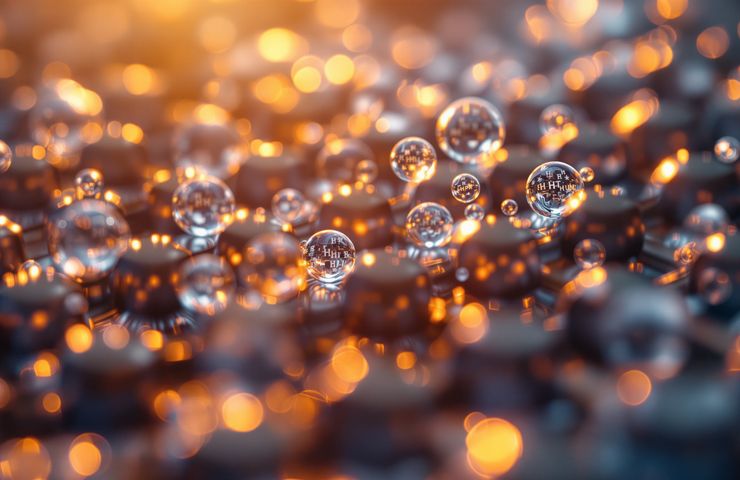
Ruthenium Catalyst Shakes Up Hydrogen Fuel Cells with Platinum-Free Boost
November 26, 2025On November 20, 2025, a research crew from Beijing University unveiled a game-changing combo: ruthenium nanoparticles anchored on a tungsten carbide (WCx) substrate. In alkaline conditions, it nails both the hydrogen evolution reaction (HER) and the hydrogen oxidation reaction (HOR) with style. In galvanostatic tests, it hit 10 mA/cm² at just a 30 mV overpotential for HER—beating commercial Pt/C’s 38 mV. For HOR, Ru-NPs/WCx chalked up 3.2 A/mg_Ru, over twice what Pt/C managed in 1.0 M KOH. And after 5,000 cycles, both reactions showed less than 10% performance drop. Using only 0.2 mg/cm² of Ru instead of 0.4 mg/cm² of Pt could cut catalyst costs by around 60%, saving hundreds of dollars per square meter of membrane electrode assembly.
Why It Matters
For decades, the world has leaned on pricey platinum, making capex sky-high and leaving manufacturers at the mercy of metal-market roller coasters. A platinum-free system that matches or tops Pt in alkaline media unlocks a whole new cost and performance frontier for hydrogen production and power generation. In anion-exchange membrane fuel cells (AEMFCs), this breakthrough could speed up stack commercialization by slashing material expenses and using non-corrosive electrolytes.
Under the Microscope
The magic lies in the strong metal-support interaction between Ru and WCx. A two-step pyrolysis at 800 °C under argon welds Ru atoms to mixed-phase tungsten carbide—proof comes from XPS and EXAFS analyses showing Ru–W bonds that fine-tune Ru’s d-orbital electrons, bringing hydrogen adsorption energy right to the volcano-plot sweet spot. The catalyst boasts an electrochemically active surface area of 78 m²/g_Ru—well above Pt/C—fueling rapid reaction kinetics at low overpotentials. Plus, WCx doesn’t dissolve easily, so those Ru nanoparticles stay anchored, cutting degradation even after thousands of cycles.
Historical Pulse
Platinum has ruled HER and HOR in electrolyzers and fuel cells for ages. Early non-Pt contenders—nickel alloys, cobalt phosphides, molybdenum sulfides—tackled one reaction but faltered on the other. The 2019–2020 platinum-price spike above $1,200/oz triggered a global rush into non-PGM research. NIH and ACS Nano papers between 2020–2022 dove into phase-engineered Ru nanostructures and transition-metal-doped Ru, clearing some hurdles but still wrestling with oxidation stability in alkaline. Europe’s KNOWHY project and US ARPA-E efforts poured money into labs chasing sub-$2/kg H₂ goals. Ru-NPs/WCx finally brings together lessons from all those efforts—metal-support synergy, phase control, scalable synthesis—into one robust electrocatalyst that ticks both durability and activity boxes.
Collateral Effects
Cutting platinum demand eases pressure on scarce Pt mines, but don’t pop the champagne yet. Ruthenium’s cheaper but still precious, and synthesizing tungsten carbide is energy- and CO₂-intensive. If demand for WCx ramps up, mining and refining footprints could swell—raising environmental and supply-chain questions. A full lifecycle analysis is a must, weighing lower replacement rates against extraction impacts.
Impact on Green Hydrogen
The cost of green hydrogen hinges on electrolyzer efficiency, capex, and supply-chain robustness. By slashing catalyst costs by up to 60% and shaving overpotentials by 20–25%, Ru-NPs/WCx could drive the levelized cost of hydrogen down by about $0.3–0.5/kg. That might undercut gray hydrogen in regions with cheap renewables, pushing LCOH into the $1.5–$1.8/kg neighborhood. If economies of scale kick in, electrolyzer OEMs will be able to offer competitively priced systems, stoking demand for sustainable energy solutions in industry, shipping, and heavy transport.
Strategic Play
China’s doubling down on a sustainable energy future, with its Five-Year Plan eyeing 100 MW of AEM electrolyzers by 2027. Ru-NPs/WCx is right in line with that roadmap, potentially powering 1 kW AEMFC prototypes by 2026. Backed by national, provincial, and postdoctoral funds, the research aligns tech policy with industrial ambition—positioning China to license this catalyst to global OEMs and shake up Western dominance in Pt-based systems.
Industry Buzz
While the research headlines crackle, big names like Ballard Power Systems, Plug Power, and Toyota are quietly scouting non-Pt routes. Snagging licensing deals or co-developing a sturdy Ru-WC system would let them ditch pricey Pt powder, streamline stack assembly, and shave system weight. Expect patent filings on Ru-WC interactions and metal-support engineering to spike next quarter.
Behind the Scenes
This discovery is built on years of global R&D—phase engineering of Ru nanostructures (see ACS Nano, 2022) and mixed-metal supports. Europe’s Horizon and US ARPA-E have poured cash into AEMFCs, chasing non-Pt breakthroughs but hitting trade-offs in durability or performance. By squeezing extra activity from Ru–W bonds, the Xiangtan team bridges lab-scale promise with real-world needs in electrolysis and hydrogen production.
A Skeptical Glance
Lab numbers are one thing; rugged, real-world deployment is another. How will Ru-NPs/WCx hold up under impurity-laden feeds, thermal cycling, and endless startup-shutdown routines? Can manufacturers slot a new catalyst powder into existing supply chains without breaking the bank? Who owns the IP, and will steep licensing fees eat into the cost advantage? Process engineers will also want CO₂ and NH₃ tolerance data. I’ll believe a true hydrogen fuels renaissance when I see 10,000-hour durability tests and OEM signoffs.
Looking Ahead
If Ru-NPs/WCx can scale, we’re looking at a potential paradigm shift in fuel cell technology and water electrolysis—chopping reliance on platinum and turbocharging industrial decarbonization. Keep an eye out for pilot-scale electrolyzer demos, stack trials with real-world feeds, and recycling schemes for spent catalysts. If real-world stacks can exceed 5,000 hours with minimal upkeep, that’s when we’ll know it’s truly a game changer. Will this catalyst shine in megawatt electrolyzer pods or just in coffee-cup rigs? Only time (and rigorous field tests) will tell—but we’re definitely a big step closer to a zero-emission future.
source: researchgate.net



 With over 15 years of reporting hydrogen news, we are your premier source for the latest updates and insights in hydrogen and renewable energy.
With over 15 years of reporting hydrogen news, we are your premier source for the latest updates and insights in hydrogen and renewable energy.